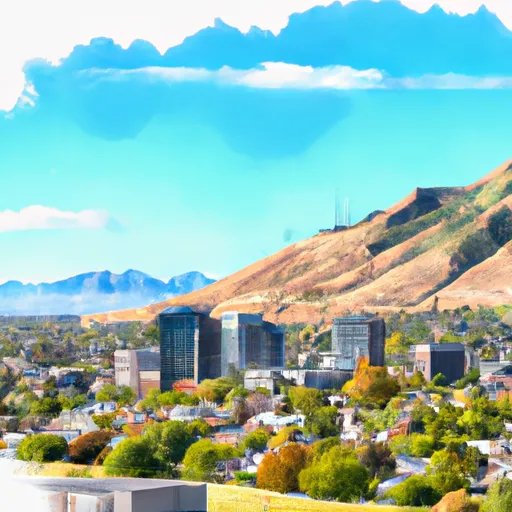-
 Snoflo Premium
Snoflo Premium
Get unlimited access to all our content
With no Ad interruptions! - Start Your Free Trial Login with existing account
Logan
Eden Index
Climate
8.2
•
Recreation
7.0
•
Community
2.5
•
Safeguard
6.4/10

Logan, Utah is a charming city nestled in Cache Valley, surrounded by picturesque mountains and a vibrant landscape. The climate in Logan is characterized by four distinct seasons. Summers are warm and dry, with temperatures averaging around 85°F, providing ideal conditions for outdoor activities. Winters, on the other hand, are cold and snowy, with temperatures falling below freezing, making it a haven for winter sports enthusiasts.
Hydrologically, Logan benefits from nearby rivers and streams, particularly the Logan River, which flows through the heart of the city. The river not only adds to the scenic beauty of the area but also offers excellent opportunities for fishing, boating, and water sports. Additionally, Logan is home to numerous reservoirs, such as Bear Lake, offering further recreational options like swimming, kayaking, and paddleboarding.
Outdoor recreation opportunities in Logan are abundant. The city is surrounded by breathtaking natural beauty, making it an ideal destination for hiking, mountain biking, and camping. Cache National Forest, situated nearby, offers trails for all skill levels, allowing visitors to explore the area's stunning wilderness. During the winter months, Logan transforms into a winter wonderland, attracting skiers and snowboarders to its nearby ski resorts. Overall, Logan provides a diverse range of outdoor activities, ensuring that nature lovers and adventure seekers alike can find their perfect recreational outlet.
What is the Eden Index?
The Snoflo Eden Index serves as a comprehensive rating system for regions, evaluating their desirability through a holistic assessment of climate health, outdoor recreation opportunities, and natural disaster risk, acknowledging the profound impact of these factors on livability and well-being.
Climate Health Indicator (CHI): 8.2
Logan receives approximately
690mm of rain per year,
with humidity levels near 63%
and air temperatures averaging around
7°C.
Logan has a plant hardyness factor of
5, meaning
plants and agriculture in this region thrive during a short period during spring and early summer. Most
plants will die off during the colder winter months.
By considering the ideal temperature range, reliable water supplies, clean air, and stable seasonal rain or snowpacks, the Climate Health Indicator (CHI) underscores the significance of a healthy climate as the foundation for quality living.
A healthy climate is paramount for ensuring a high quality of life and livability in a region, fostering both physical well-being and environmental harmony. This can be characterized by ideal temperatures, reliable access to water supplies, clean air, and consistent seasonal rain or snowpacks.
Weather Forecast
Streamflow Conditions
Lower Bear
Area Rivers
Lower Bear
Snowpack Depths
Lower Bear
Reservoir Storage Capacity
Lower Bear
Groundwater Levels
Recreational Opportunity Index (ROI): 7.0
The Recreational Opportunity Index (ROI) recognizes the value of outdoor recreational options, such as parks, hiking trails, camping sites, and fishing spots, while acknowledging that climate plays a pivotal role in ensuring the comfort and consistency of these experiences.
Access to outdoor recreational opportunities, encompassing activities such as parks, hiking, camping, and fishing, is crucial for overall well-being, and the climate plays a pivotal role in enabling and enhancing these experiences, ensuring that individuals can engage in nature-based activities comfortably and consistently.
Camping Areas
| Campground | Campsites | Reservations | Toilets | Showers | Elevation |
|---|---|---|---|---|---|
| Maple Grove | 12 | 4,907 ft | |||
| Smithfield | 6 | 5,566 ft | |||
| High Creek | 2 | 5,521 ft | |||
| Redpoint | 10 | 4,889 ft | |||
| Willow Flat | 55 | 6,108 ft | |||
| Tony Grove Lake | 41 | 8,111 ft | |||
| Albert Moser | 9 | 5,281 ft |
Nearby Fishing
Nearby Ski Areas
Catastrophe Safeguard Index (CSI):
The Catastrophe Safeguard Index (CSI) recognizes that natural disaster risk, encompassing floods, fires, hurricanes, and tornadoes, can drastically affect safety and the overall appeal of an area.
The level of natural disaster risk in a region significantly affects safety and the overall livability, with climate change amplifying these risks by potentially increasing the frequency and intensity of events like floods, fires, hurricanes, and tornadoes, thereby posing substantial challenges to community resilience and well-being.
Community Resilience Indicator (CRI): 2.5
The Community Resilience Indicator (CRI) recognizes that education, healthcare, and socioeconomics are crucial to the well-being of a region. The CRI acknowledges the profound impact of these elements on residents' overall quality of life. By evaluating educational resources, healthcare accessibility, and economic inclusivity, the index captures the essential aspects that contribute to a thriving community, fostering resident satisfaction, equity, and social cohesion.

